
- Display 45 Products per page
-

Your Activity Guide for Teaching Bike Safety Skills
Guide, Revised 2020
This booklet is for any individual to use in educating children and youth about bicycle safety. These nine activities are designed for teaching bike safety skills for children ages 5 – 12. Included are speaking notes, notes to the educator, items required for the activities, and tools to support the activity (e.g., diagrams and photos). This booklet will help individuals focus on the importance of safe cycling through education.
SKU: 4-217 -

Winter Safety
Fact Sheet, Revised 2019
This fact sheet provides tips on winter safety and includes a colouring page.
SKU: 4-020 -

When Your Baby Can’t Stop Crying
Brochure, Revised 2019
Although infant crying is normal, it can be very frustrating for caregivers. This brochure identifies strategies for dealing with a crying infant, as well as strategies for handling caregivers’ frustration. Ideal for use with all caregivers. For information aimed at professionals and service providers, see Abusive Head Trauma (Shaken Baby Syndrome) (resource 4-900).
SKU: 4-902 -

Walking School Bus: A Guide for Parents and Teachers
Guide and Manual, 2010
A Walking School Bus (WSB) is a group of children (passengers) and adults (drivers and conductors) who walk to and from school along a designated, safe route. The “bus” picks up students and drops them off in the reverse order in the afternoon. This guide identifies the benefits, such as safety, environmental, and health of a WSB. It also goes through the process needed to set up a Walking School Bus.
SKU: 4-305 -

Unintentional Poisoning Summary and Prevention Tips
Fact Sheet, 2018
This summary provides information about unintentional poisoning-related hospitalizations for Saskatchewan children under the age of 10, between 2004 and 2013. Information about how to prevent unintentional poisonings in children is also provided.
SKU: 4-401 -
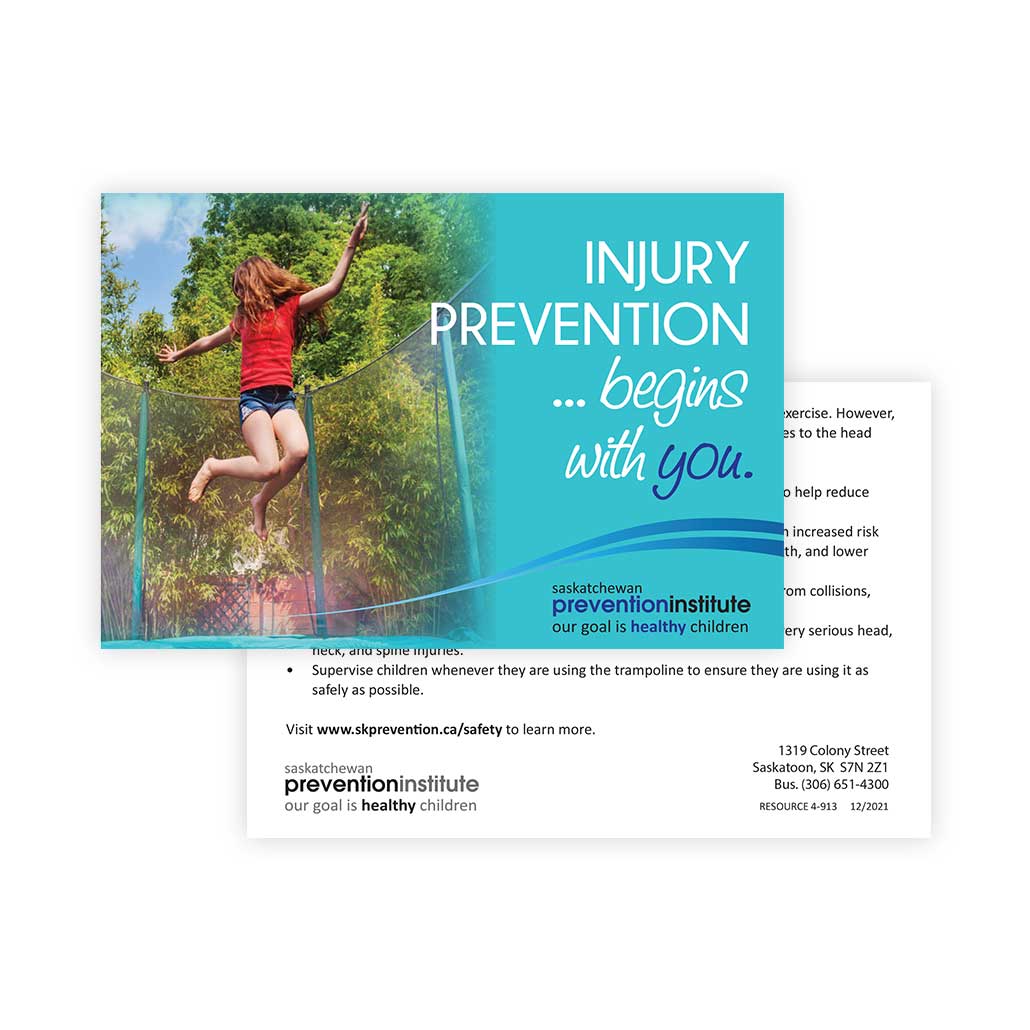
Trampoline Safety Information Card
Information Card, 2021
This information card is part of the Injury prevention begins with you campaign, and shares tips for how you can prevent trampoline injuries in children.
SKU: 4-913 -
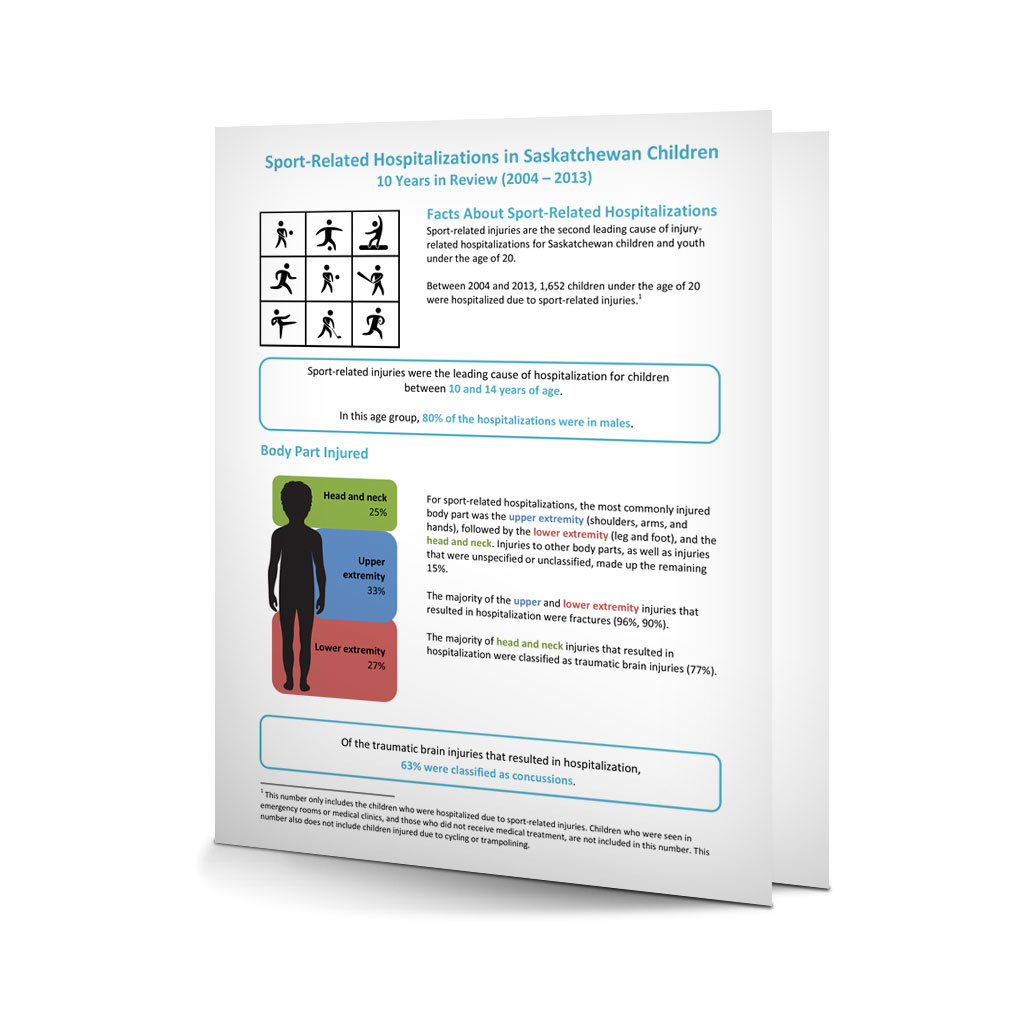
Sport-Related Hospitalizations Summary
Fact Sheet, 2018
This summary provides information about sport-related hospitalizations for Saskatchewan children under the age of 20, between 2004 and 2013. Information about how to prevent sport-related injuries in children is also provided.
SKU: 4-403 -
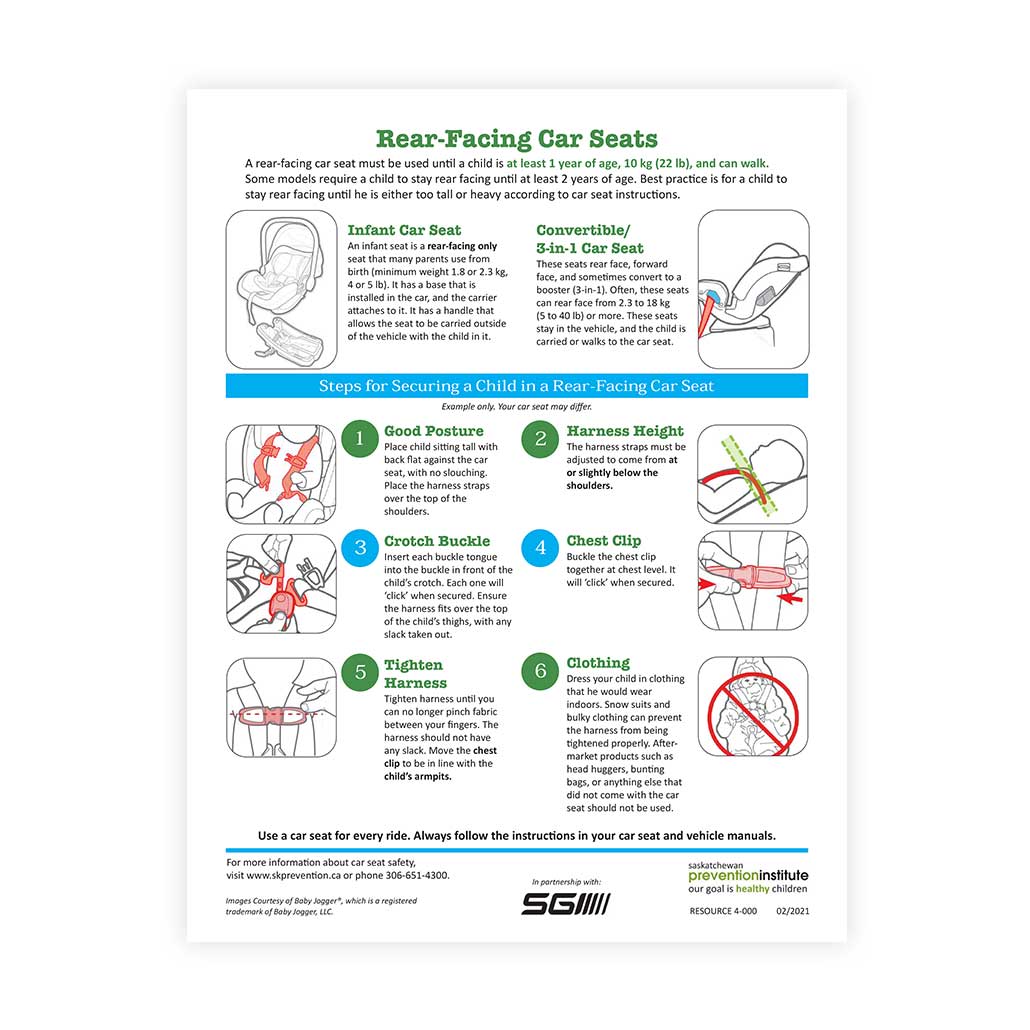
Rear-Facing Car Seats
Fact Sheet, Revised 2022
This fact sheet explains the different types of rear-facing car seats and how to properly buckle and tighten a child into one.
Please note: This resource is a pad of 50 fact sheets. An order quantity of 1 equals 50 fact sheets.SKU: 4-000 -
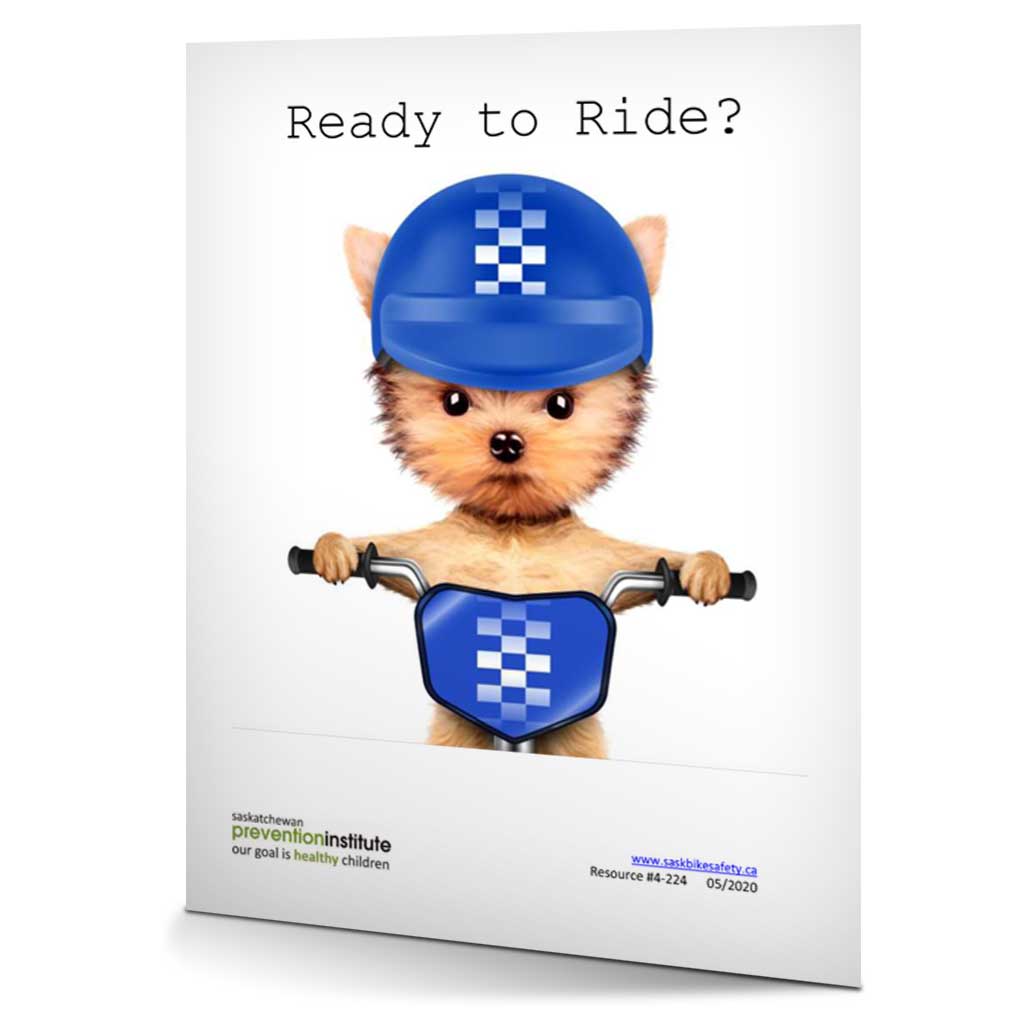
Ready to Ride?
Booklet, Revised 2021
Children (ages 5-12), their caregivers, and educators can find out how to stay safe while biking. This booklet answers the following questions: why bike safety is important, what should I wear when I ride my bike, why should I wear a bike helmet, what’s the right bike for me, and what road rules should I know?
SKU: 4-224 -
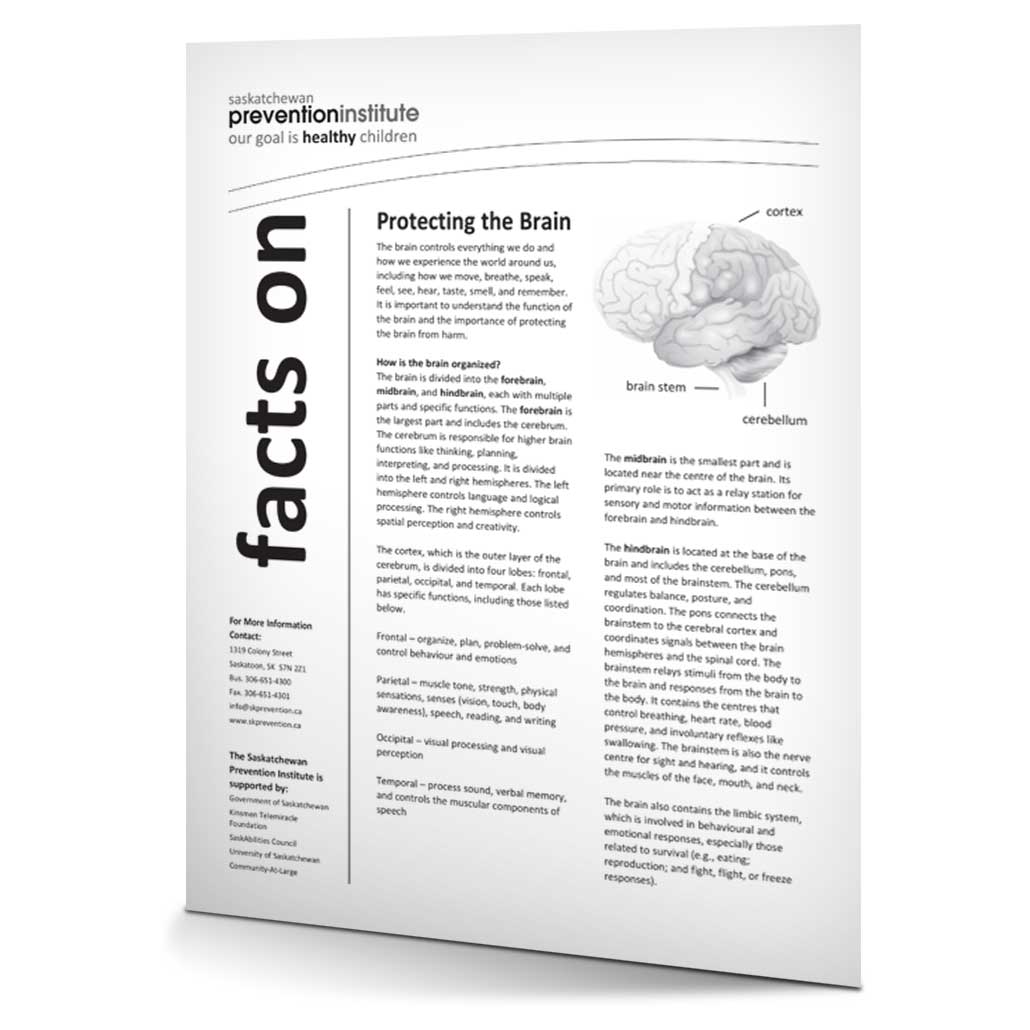
Protecting the Brain
Fact Sheet, Revised 2019
The brain enables us to do everything that we do – breathe, walk, plan for our futures, and makes us who we are as individuals. It is important to understand how the brain works so we can protect it as best as possible.
SKU: 4-005 -
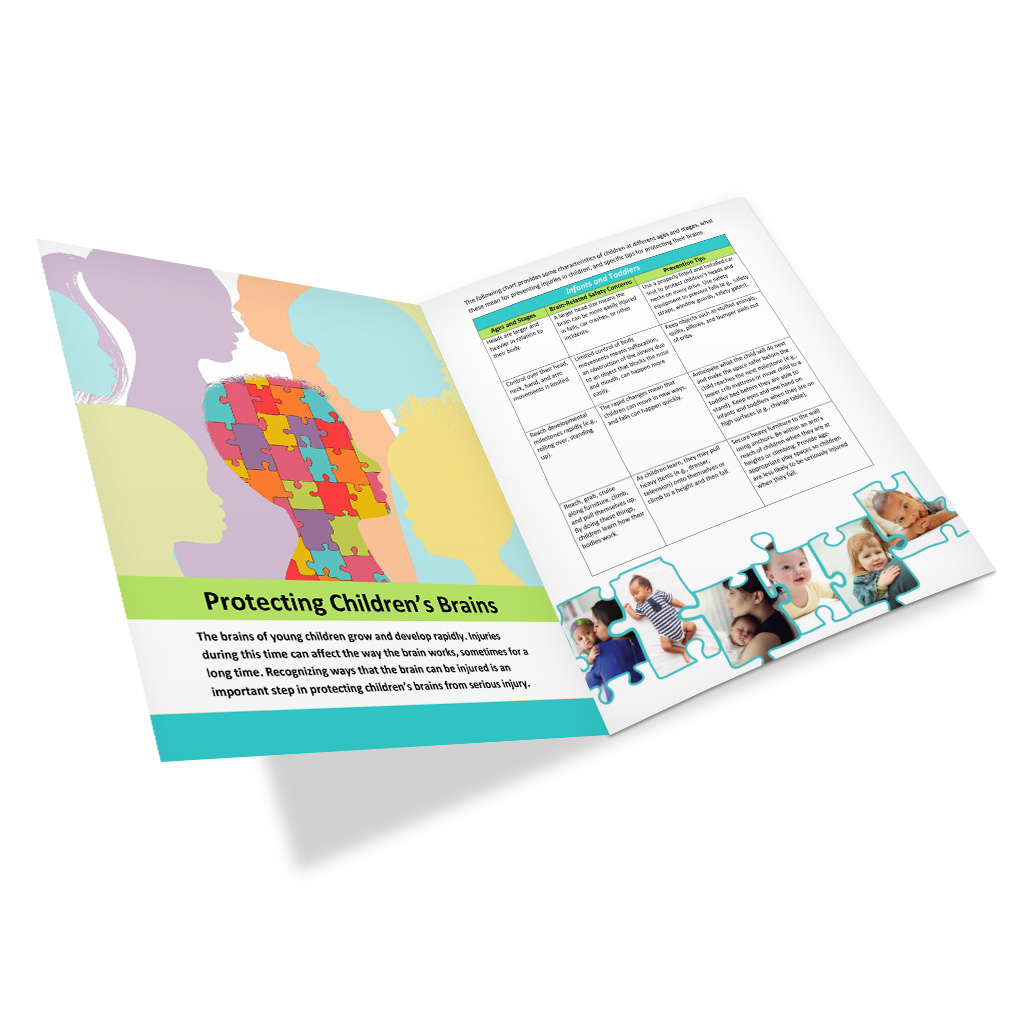
Protecting Children’s Brains
Brochure, 2022
This brochure contains information about characteristics of children at different ages and stages, what this means for their safety, and prevention tips for protecting their brains.
SKU: 4-219 -

Protect Your Baby’s Head Shape: Preventing Flat Spots on Your Baby’s Head
Brochure, Revised 2023
This brochure provides parents and caregivers with information on positional plagiocephaly, or “flat head”. Information includes how to prevent flat spots and what to do if a flat spot is found on baby’s head.
SKU: 4-101 -

Promoting Risky Play Information Card
Information Card, 2021
This information card is part of the Injury prevention begins with you campaign, and shares tips for how you can promote children’s risky play.
SKU: 4-912 -

Preventing Injuries
Fact Sheet, 2010
Injuries are the leading cause of death for Saskatchewan children. This fact sheet defines the differences between injuries and “accidents,” outlines the causes of injuries, and identifies the different types of strategies that can be used to prevent injuries.
SKU: 4-003 -
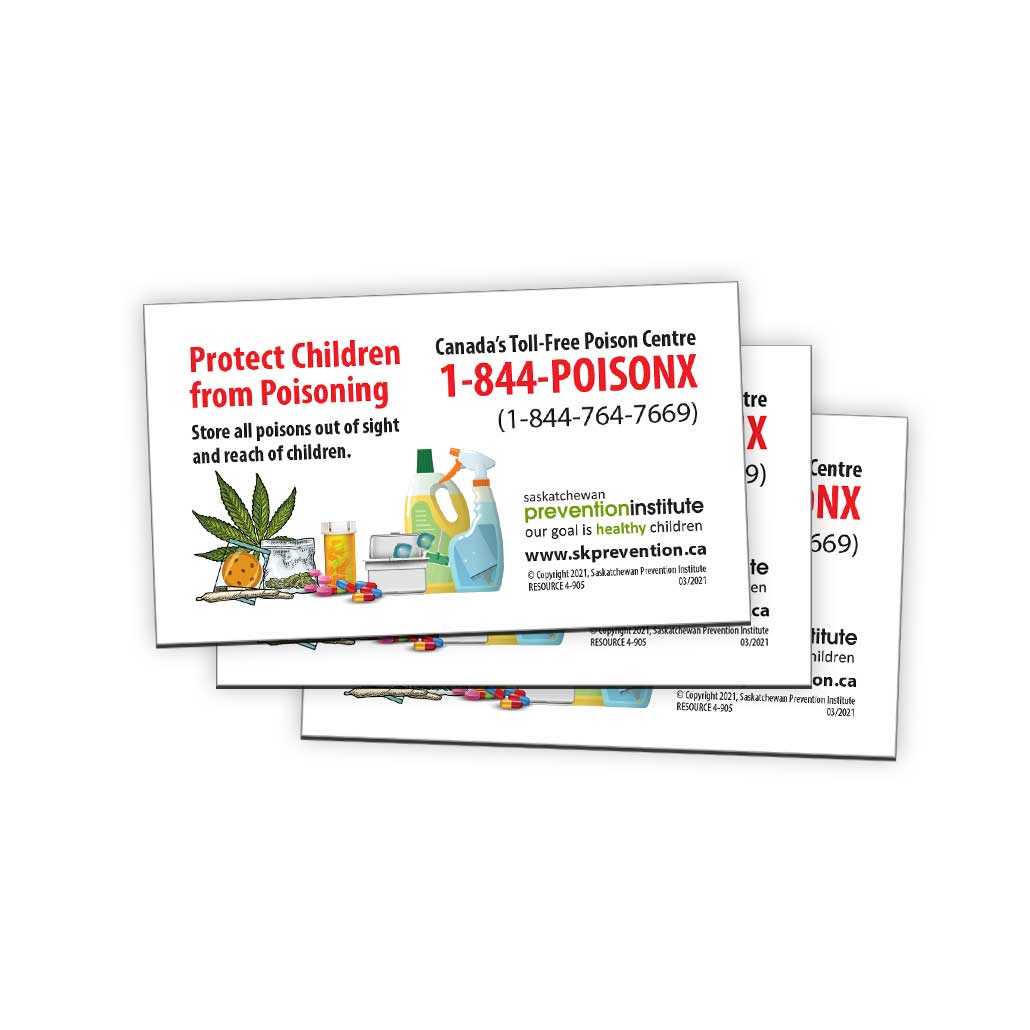
Poison Prevention Magnet
Information Card, 2023
This refrigerator magnet provides a reminder of Canada’s national toll-free poison centre number, 1-844-POISON-X or 1-844-764-7669.
SKU: 4-905 -

Poison Prevention Guide
Guide and Manual, 2021
This guide is for anyone who works with children and their families, and can be used to educate children and families about home and personal safety related to poisoning prevention. There are activities for both children and adults in the guide. There are activity pages at the end of the guide that can be photocopied.
SKU: 4-906 -

Playground Safety
Fact Sheet, 2005
Every year in Saskatchewan, children between the ages of one and nine years are hospitalized due to playground injuries. This fact sheet outlines the steps parents can take to protect their children. Includes a checklist for ensuring their local playgrounds are safe and well-maintained.
SKU: 4-800 -

Million Messages: Program
Information Card, 2012
The Million Messages program is the development of a comprehensive plan to standardize messages given to parents about injury by public or community health nurses. Each of these messages is simple, consistent, routine, and targets an issue that affects children at specific stages in their growth and development. The messages are developed for visits during the prenatal, newborn, two months, four months, six months, twelve months, eighteen months, and preschool periods. This program was developed by Capital Health in Alberta.
SKU: 4-357 -
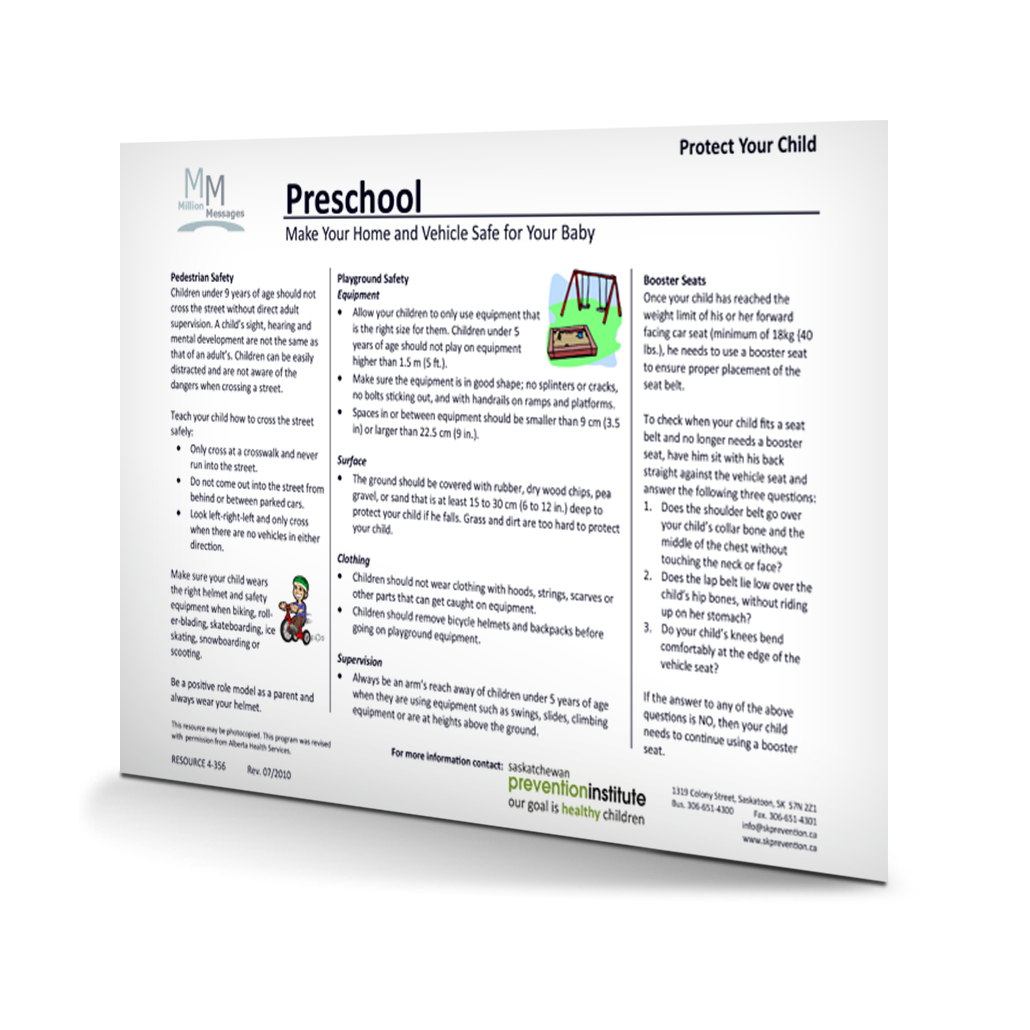
Million Messages: Preschool
Information Card, 2012
The Million Messages program is the development of a comprehensive plan to standardize messages given to parents about injury by public or community health nurses. Each of these messages is simple, consistent, routine, and targets an issue that affects children at specific stages in their growth and development. The messages are developed for visits during the prenatal, newborn, two months, four months, six months, twelve months, eighteen months, and preschool periods. This program was developed by Capital Health in Alberta.
SKU: 4-356 -

Million Messages: Prenatal
Information Card, 2012
The Million Messages program is the development of a comprehensive plan to standardize messages given to parents about injury by public or community health nurses. Each of these messages is simple, consistent, routine, and targets an issue that affects children at specific stages in their growth and development. The messages are developed for visits during the prenatal, newborn, two months, four months, six months, twelve months, eighteen months, and preschool periods. This program was developed by Capital Health in Alberta.
SKU: 4-351 -

Million Messages: Key Messages Table
Information Sheet, 2012
The Million Messages program is the development of a comprehensive plan to standardize messages given to parents about injury by public or community health nurses. Each of these messages is simple, consistent, routine, and targets an issue that affects children at specific stages in their growth and development. The messages are developed for visits during the prenatal, newborn, two months, four months, six months, twelve months, eighteen months, and preschool periods. This program was developed by Capital Health in Alberta.
SKU: 4-350 -
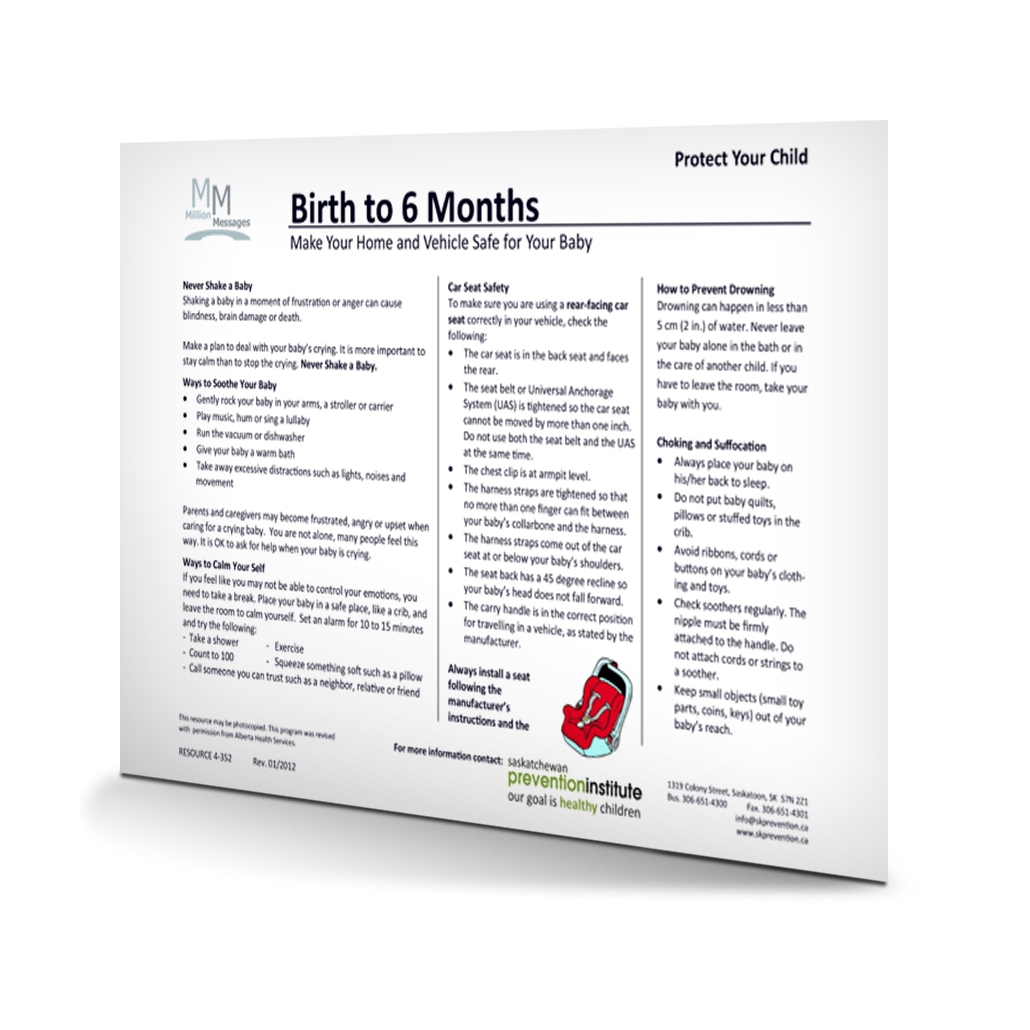
Million Messages: Birth to 6 Months
Information Card, 2012
The Million Messages program is the development of a comprehensive plan to standardize messages given to parents about injury by public or community health nurses. Each of these messages is simple, consistent, routine, and targets an issue that affects children at specific stages in their growth and development. The messages are developed for visits during the prenatal, newborn, two months, four months, six months, twelve months, eighteen months, and preschool periods. This program was developed by Capital Health in Alberta.
SKU: 4-352 -
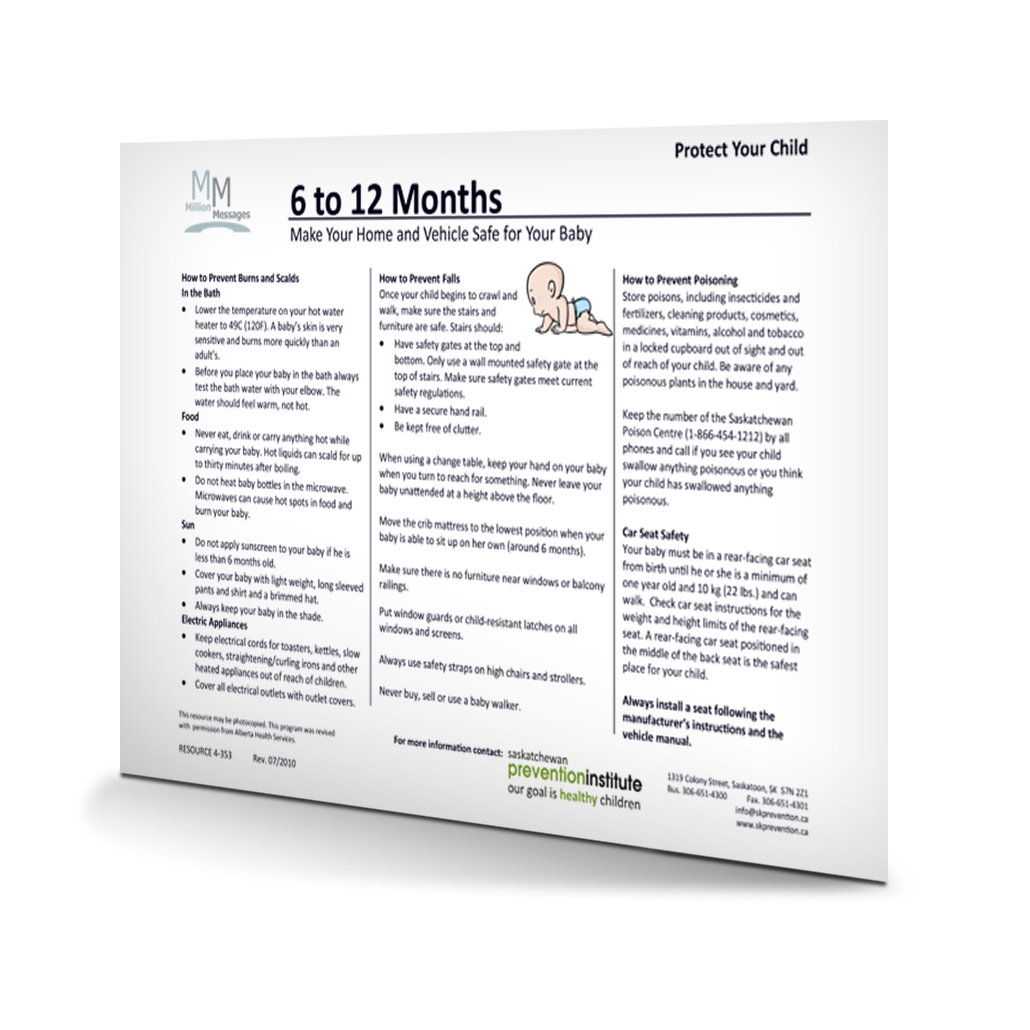
Million Messages: 6 to 12 Months
Information Card, 2012
The Million Messages program is the development of a comprehensive plan to standardize messages given to parents about injury by public or community health nurses. Each of these messages is simple, consistent, routine, and targets an issue that affects children at specific stages in their growth and development. The messages are developed for visits during the prenatal, newborn, two months, four months, six months, twelve months, eighteen months, and preschool periods. This program was developed by Capital Health in Alberta.
SKU: 4-353 -
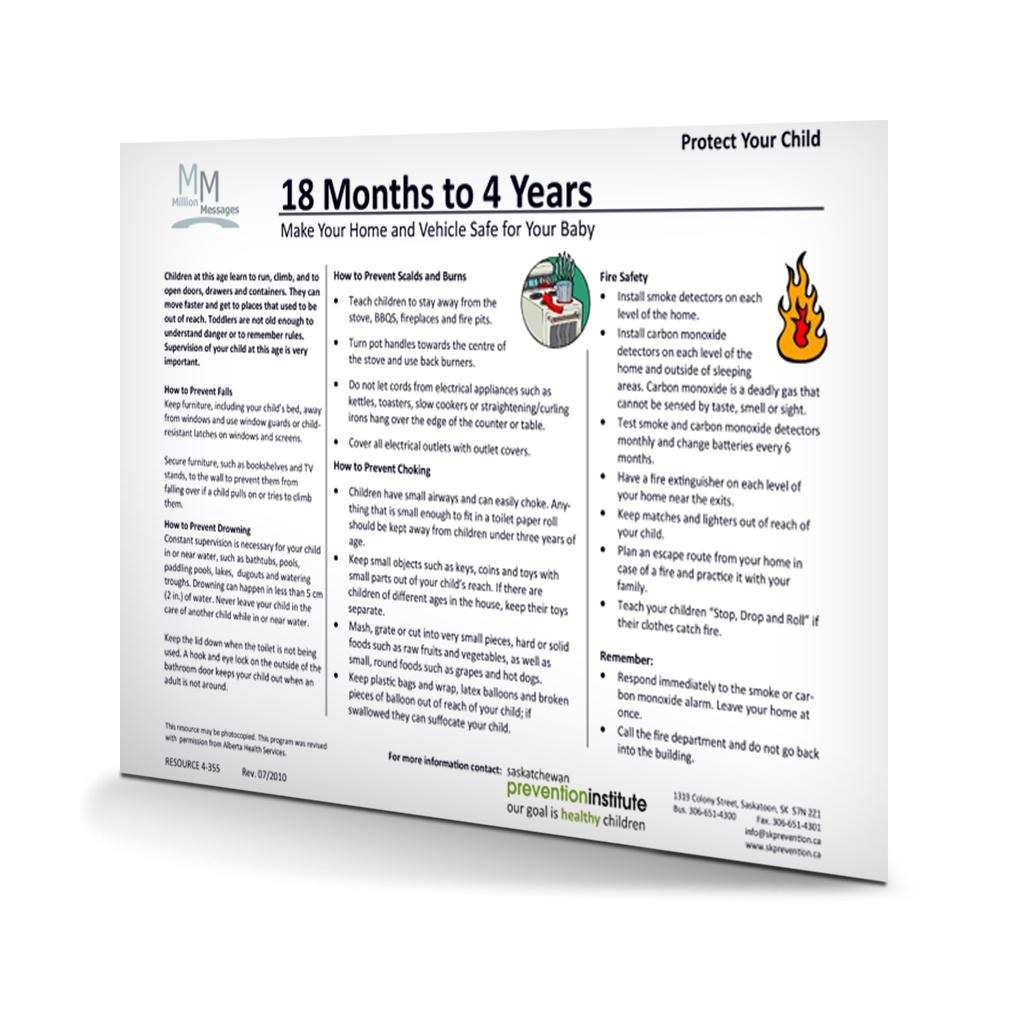
Million Messages: 18 Months to 4 Years
Information Card, 2012
The Million Messages program is the development of a comprehensive plan to standardize messages given to parents about injury by public or community health nurses. Each of these messages is simple, consistent, routine, and targets an issue that affects children at specific stages in their growth and development. The messages are developed for visits during the prenatal, newborn, two months, four months, six months, twelve months, eighteen months, and preschool periods. This program was developed by Capital Health in Alberta.
SKU: 4-355 -
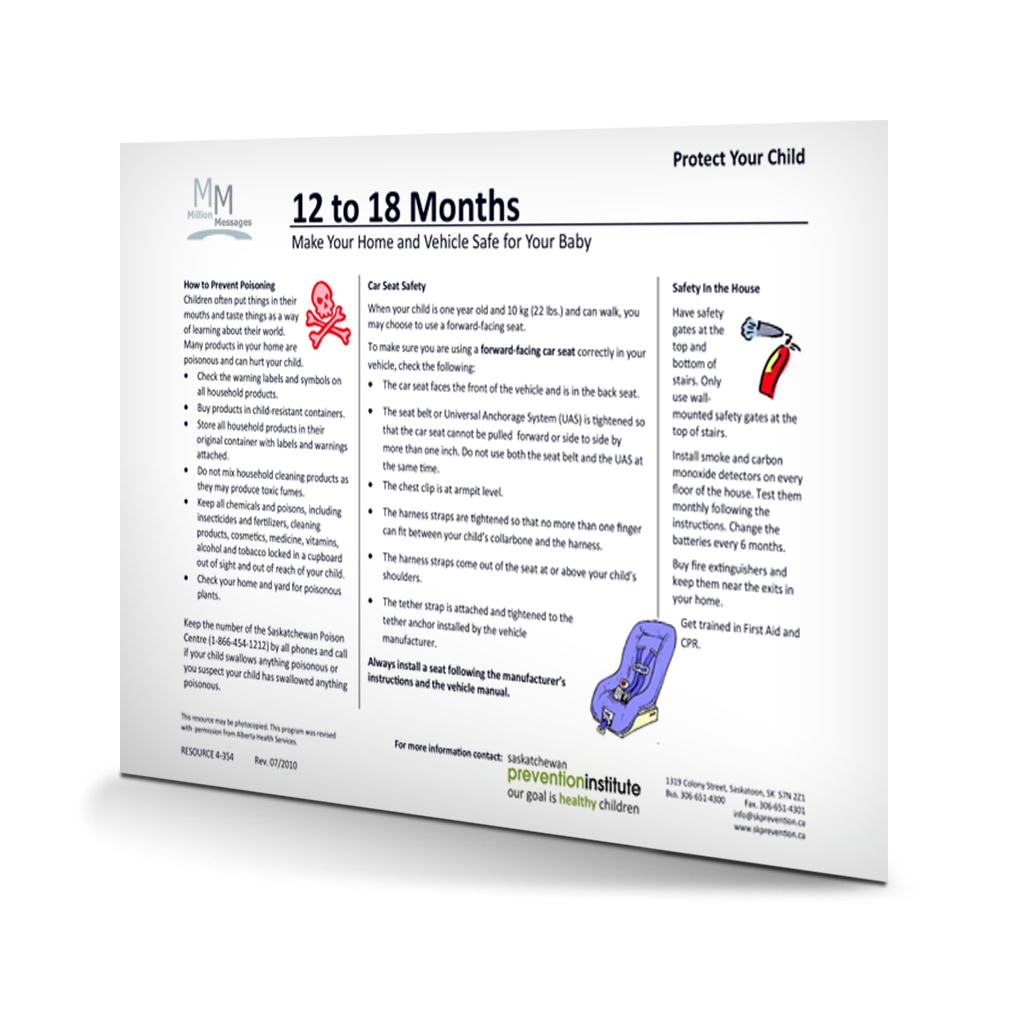
Million Messages: 12 to 18 Months
Information Card, 2012
The Million Messages program is the development of a comprehensive plan to standardize messages given to parents about injury by public or community health nurses. Each of these messages is simple, consistent, routine, and targets an issue that affects children at specific stages in their growth and development. The messages are developed for visits during the prenatal, newborn, two months, four months, six months, twelve months, eighteen months, and preschool periods. This program was developed by Capital Health in Alberta.
SKU: 4-354 -

I’m Growing up Safely – Growth Chart
Poster, Revised 2011
This resource provides home safety information for parents and caregivers in the form of a children’s growth chart. The growth chart reaches a maximum height of 90 cm (36 inches or 3 feet) and is intended for children between birth and 2 years of age.
SKU: 4-012 -

How to Prevent Poisoning
Fact Sheet, Revised 2024
Contains information on how to prevent poisoning and a checklist for poison-proofing your home.
SKU: 4-400 -
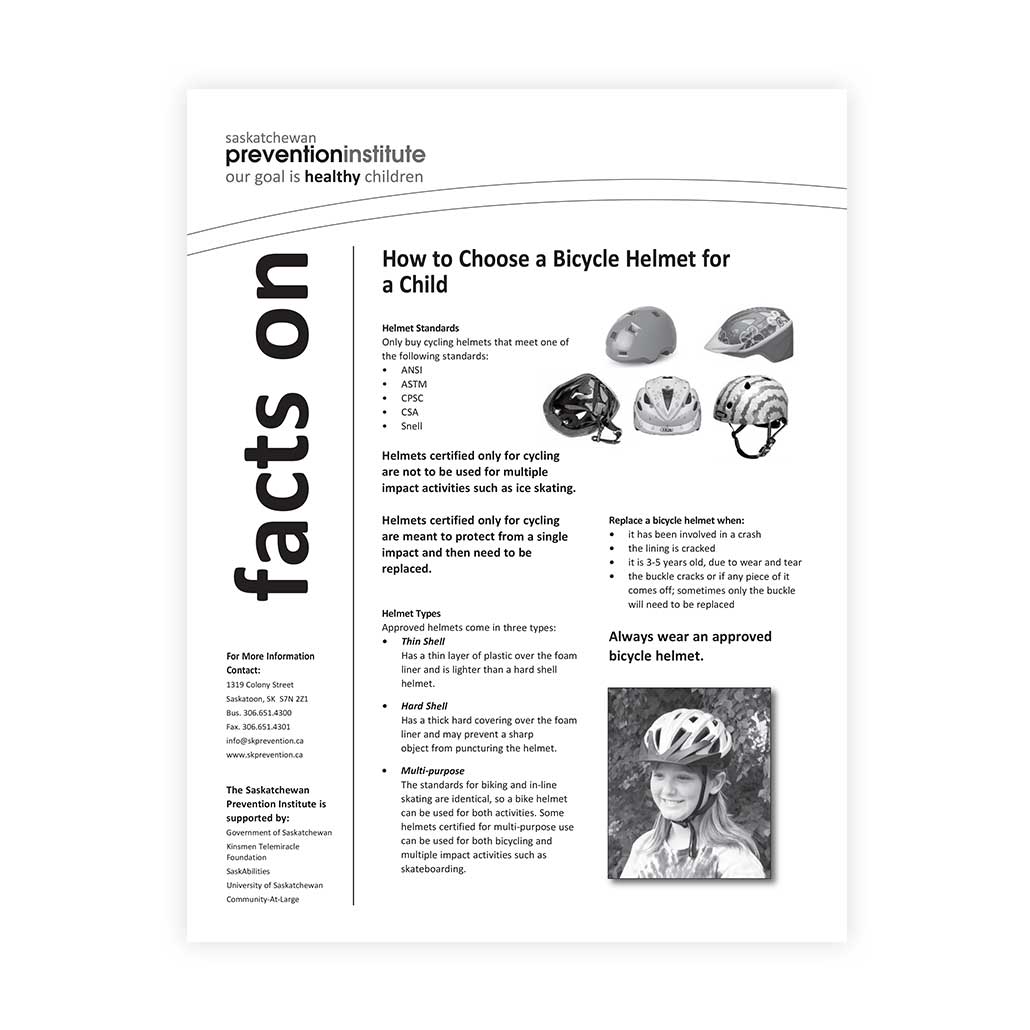
How to Choose a Bicycle Helmet for a Child
Fact Sheet, Revised 2022
This document provides information on the standards for helmets, types of helmets, and how to adjust a helmet for proper fit.
SKU: 4-201 -

Home Safety Tips: Birth to 1 Year
Booklet, Revised 2022
All children depend on the adults around them to provide safe, healthy environments to learn, grow, and develop new skills. This booklet will support caregivers in preparing for each stage of child development, to better predict and prevent injuries to children from birth to 1 year of age.
Safety tips are included on the following topics: safe sleep, coping with crying, burns, scalds, drowning, falls, choking, and car seats.Also available: Home Safety Tips: 1 to 4 Years, and Home Safety Tips: 5 to 9 YearsSKU: 4-023 -
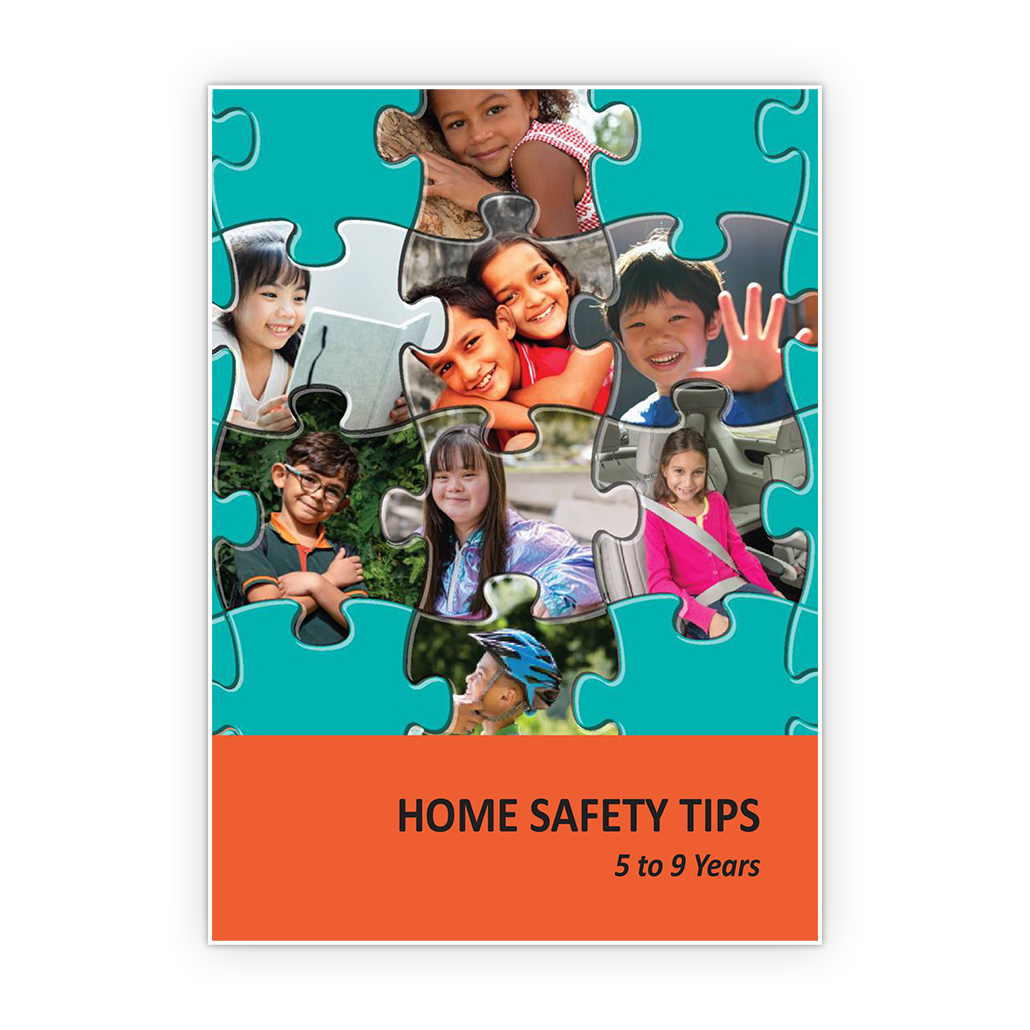
Home Safety Tips: 5 to 9 Years
Booklet, Revised 2023
All children depend on the adults around them to provide safe, healthy environments to learn, grow, and develop new skills. This booklet will support caregivers in preparing for each stage of child development, to better predict and prevent injuries to children from 5 to 9 years of age.
Safety tips are included for at home and in the community and address the following topics: falls, playgrounds, trampolines, choking, poisoning, bike and wheel safety, pedestrian safety, drowning, and car seats.
Also available: Home Safety Tips: Birth to 1 Year, and Home Safety Tips: 1 to 4 YearsSKU: 4-025 -

Home Safety Tips: 1 to 4 Years
Booklet, Revised 2023
All children depend on the adults around them to provide safe, healthy environments to learn, grow, and develop new skills. This booklet will support caregivers in preparing for each stage of child development, to better predict and prevent injuries to children from 1 to 4 years of age.
Safety tips are organized by activity, and address the following topics: safe sleep, drowning, burns, scalds, choking, poisoning, bike and wheel safety, car seats, and pedestrian safety.
Also available: Home Safety Tips: Birth to 1 Year, and Home Safety Tips: 5 to 9 YearsSKU: 4-024 -
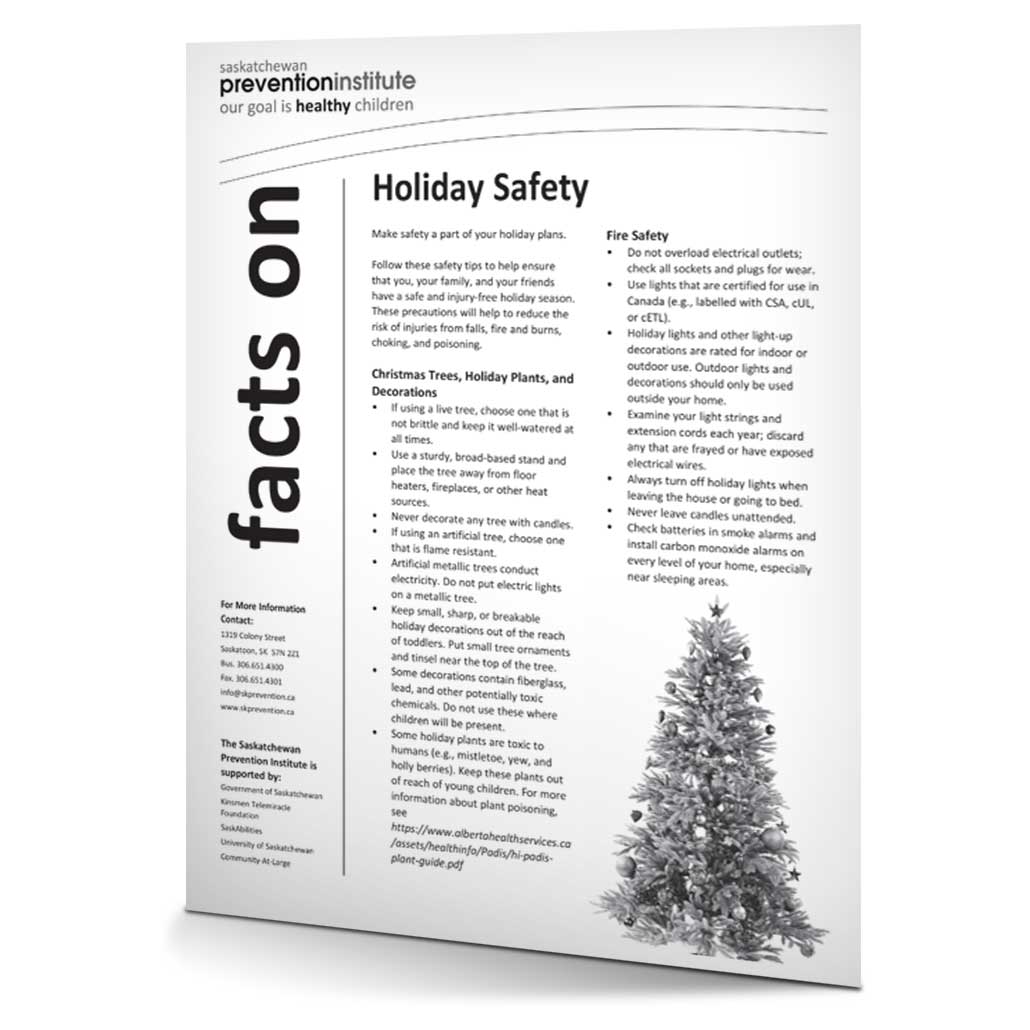
Holiday Safety
Fact Sheet, Revised 2019
This fact sheet provides safety tips to help ensure an injury-free holiday season and includes a colouring page.
SKU: 4-019 -
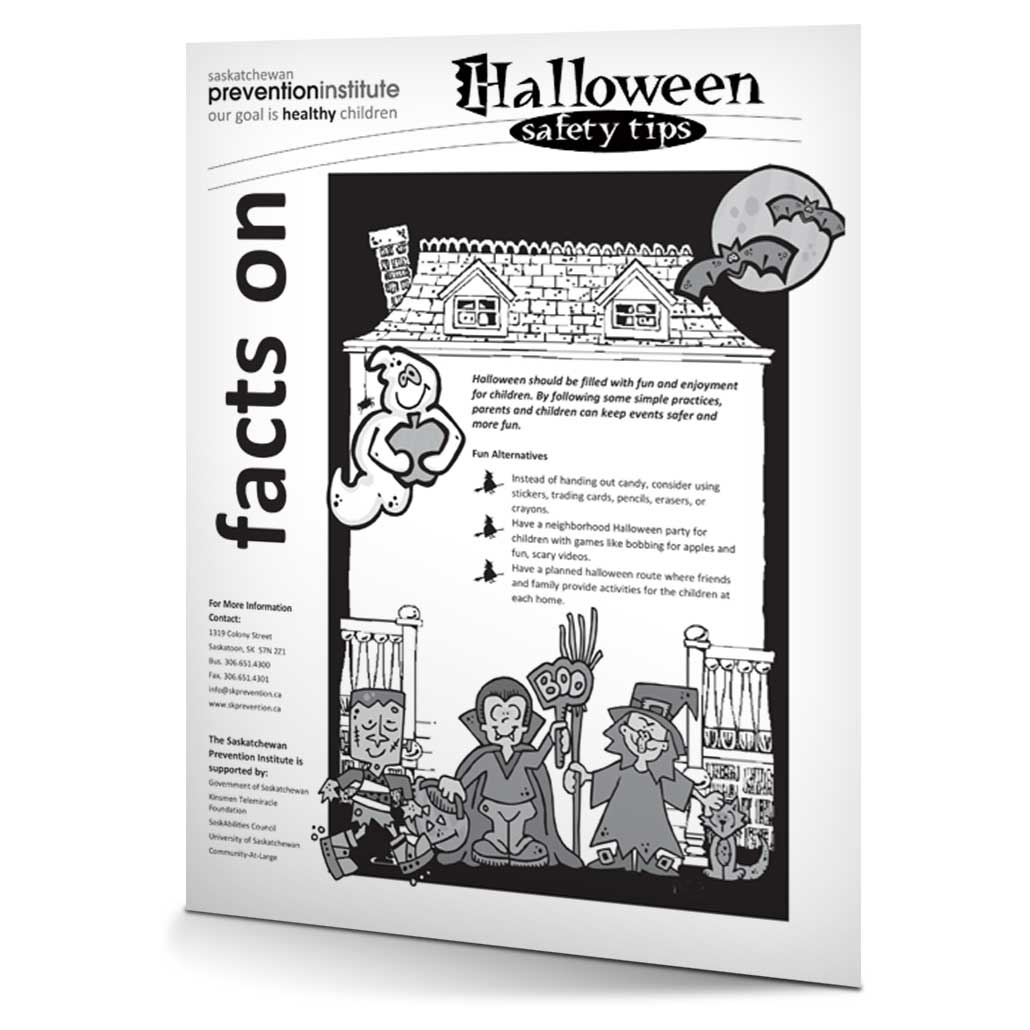
Halloween Safety
Fact Sheet, Revised 2019
This fact sheet provides Halloween safety tips and includes a colouring page.
SKU: 4-018 -

Gotta Brain Getta Helmet
Booklet, 2018
This booklet provides safety information about helmet use for a variety of activities. It also includes an example of a young boy’s experience of a head injury.*
As part of the Gotta Brain Getta Helmet booklet, view this video featuring Savannah Smith, a motocross rider from Saskatchewan. Savannah shares information about her experiences, the importance of wearing a properly fitted helmet, and how to choose a helmet.
*This booklet contains an impactful image showing a head injury that resulted from a child falling from a bicycle without a helmet. This image is better suited for older children.
SKU: 4-220 -

Forward-Facing Car Seats
Fact Sheet, Revised 2022
This fact sheet explains the different types of forward-facing car seats, describes how to properly secure the child into one, and contains car seat installation tips.
Please note: This resource is a pad of 50 fact sheets. An order quantity of 1 equals 50 fact sheets.SKU: 4-125 -
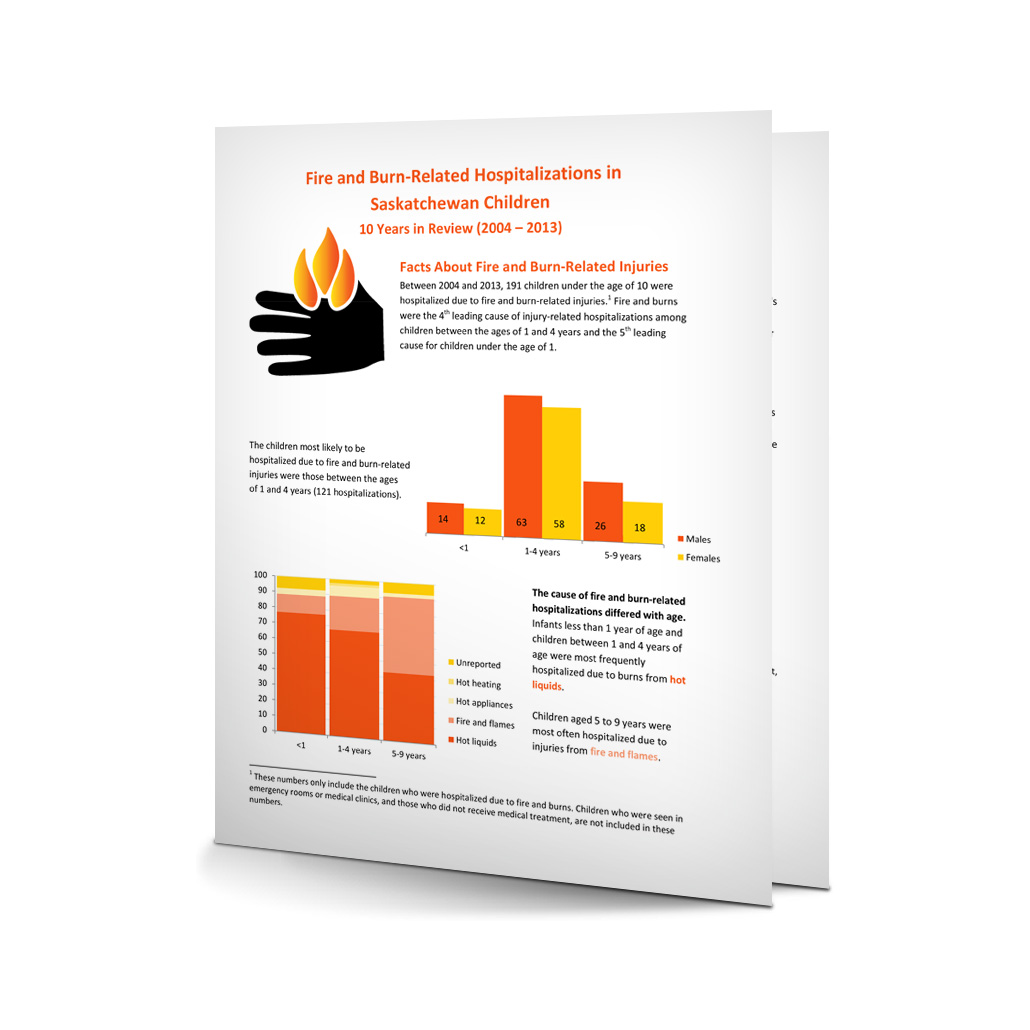
Fire and Burn-Related Hospitalizations Summary
Fact Sheet, 2018
This summary provides information about fire and burn-related hospitalizations for Saskatchewan children under the age of 10, between 2004 and 2013. Information about how to prevent fire and burn-related injuries in children is also provided.
SKU: 4-405 -

Farm Safety
Fact Sheet, 2010
Every year, children are injured on Saskatchewan farms. This information sheet was developed to assist families in making the farm a safe place for children and outlines ways to help prevent injuries.
SKU: 4-600 -
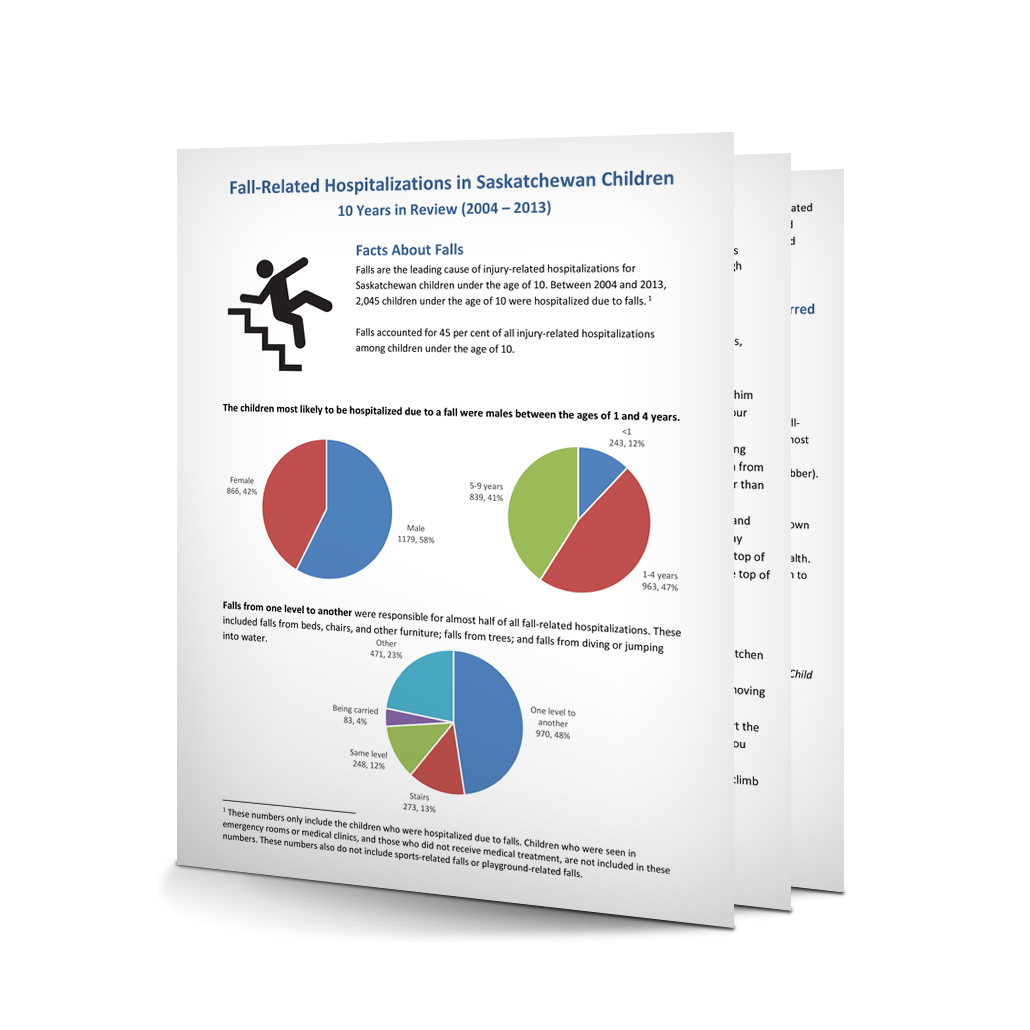
Fall-Related Hospitalizations Summary
Fact Sheet, 2018
This summary provides information about fall-related hospitalizations for Saskatchewan children under the age of 10, between 2004 and 2013. Information about how to prevent fall-related injuries in children is also provided.
SKU: 4-402 -

Elijah’s Story
Video, 2000
Elijah’s Story is the true story of a 16-month-old baby boy who was shaken to death by his biological father. The film follows the young family from the birth of Elijah to the 911 emergency call and sentencing hearing. Testimonies are given by Elijah’s mom and grandparents, as well as by the doctor, detective, and judge in the case. Elijah’s mom shares her emotions as she tries to go on, and Elijah’s dad speaks out from prison, encouraging others to learn from his mistakes.
SKU: 4-V-402 -

Electronic Cigarettes (e-cigarettes) and Risks to Children
Fact Sheet, Revised 2017
This fact sheet defines what electronic cigarette devices are and how they can be harmful to the health of children and youth. This resource outlines tips for parents to avoid injury or accidental poisoning from electronic cigarettes.
SKU: 4-301 -

Drowning Prevention Information Card
Information Card, 2021
This information card is part of the Injury prevention begins with you campaign, and shares tips for how you can prevent drowning injuries in children.
SKU: 4-911 -
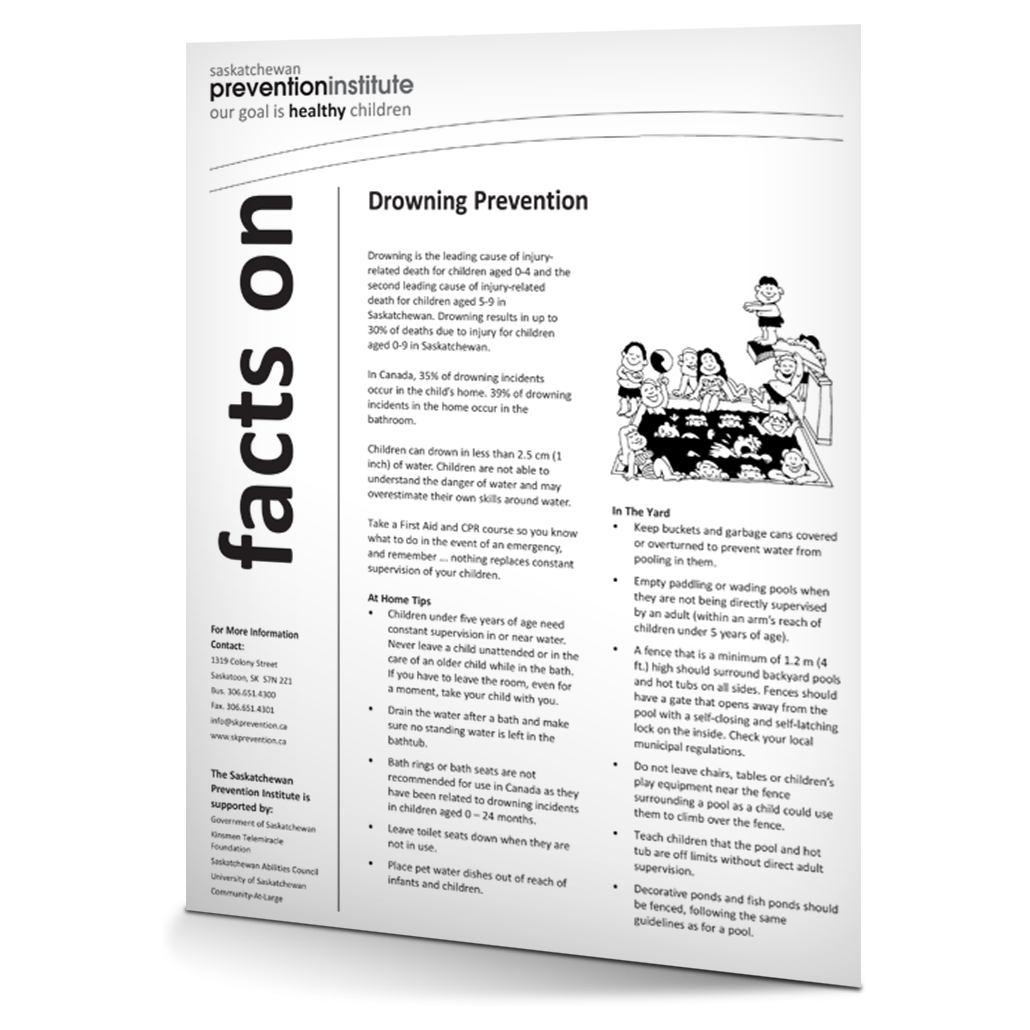
Drowning Prevention
Fact Sheet, 2010
Drowning can happen swiftly and silently. In Saskatchewan, drowning is the leading cause of death due to injury among children birth to four years of age and is the second leading cause of death due to injury among children five to nine years of age. The fact sheet outlines ways to assist you in protecting your family from drowning. Ideal for families and professionals working in the area of child safety.
SKU: 4-500 -
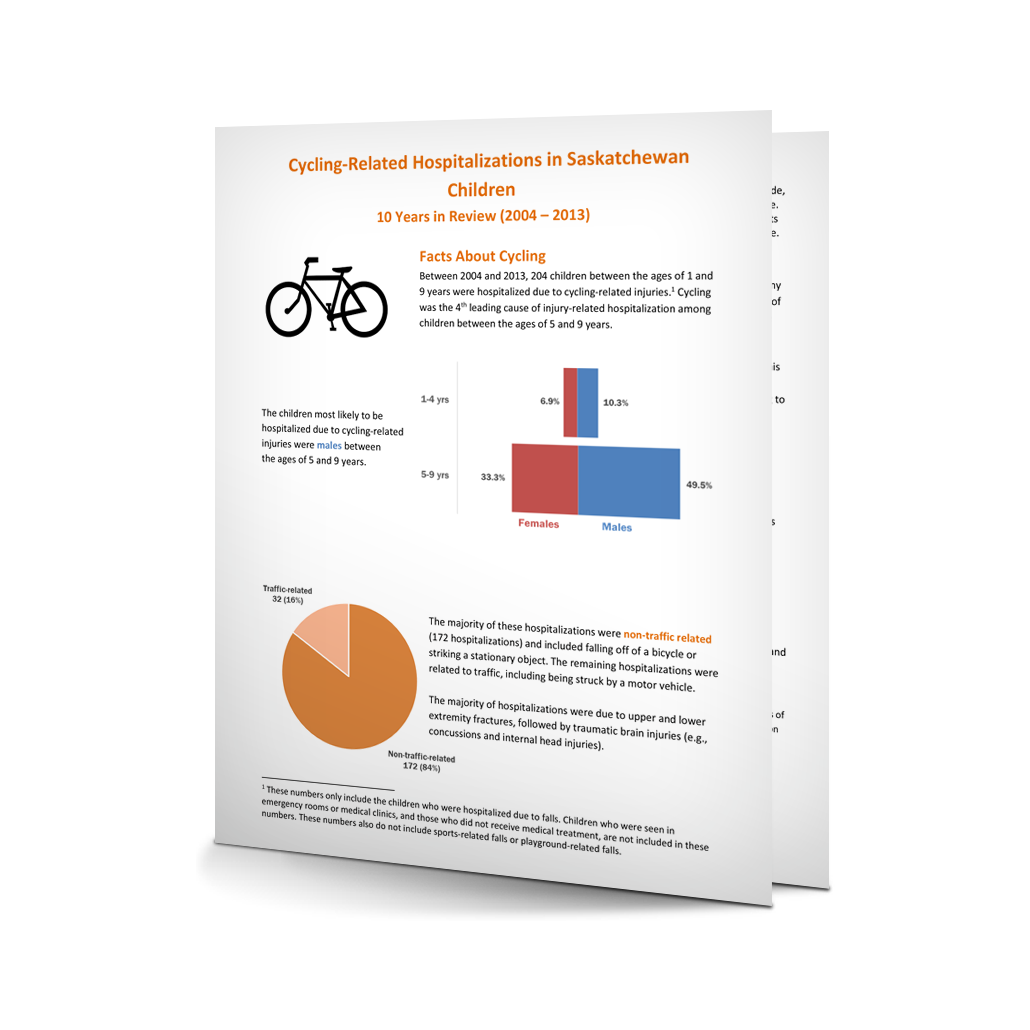
Cycling-Related Hospitalizations Summary
Fact Sheet, 2018
This summary provides information about cycling-related injury hospitalizations for Saskatchewan children under the age of 10, between 2004 and 2013. Information about how to prevent cycling-related injuries in children is also provided.
SKU: 4-404 -
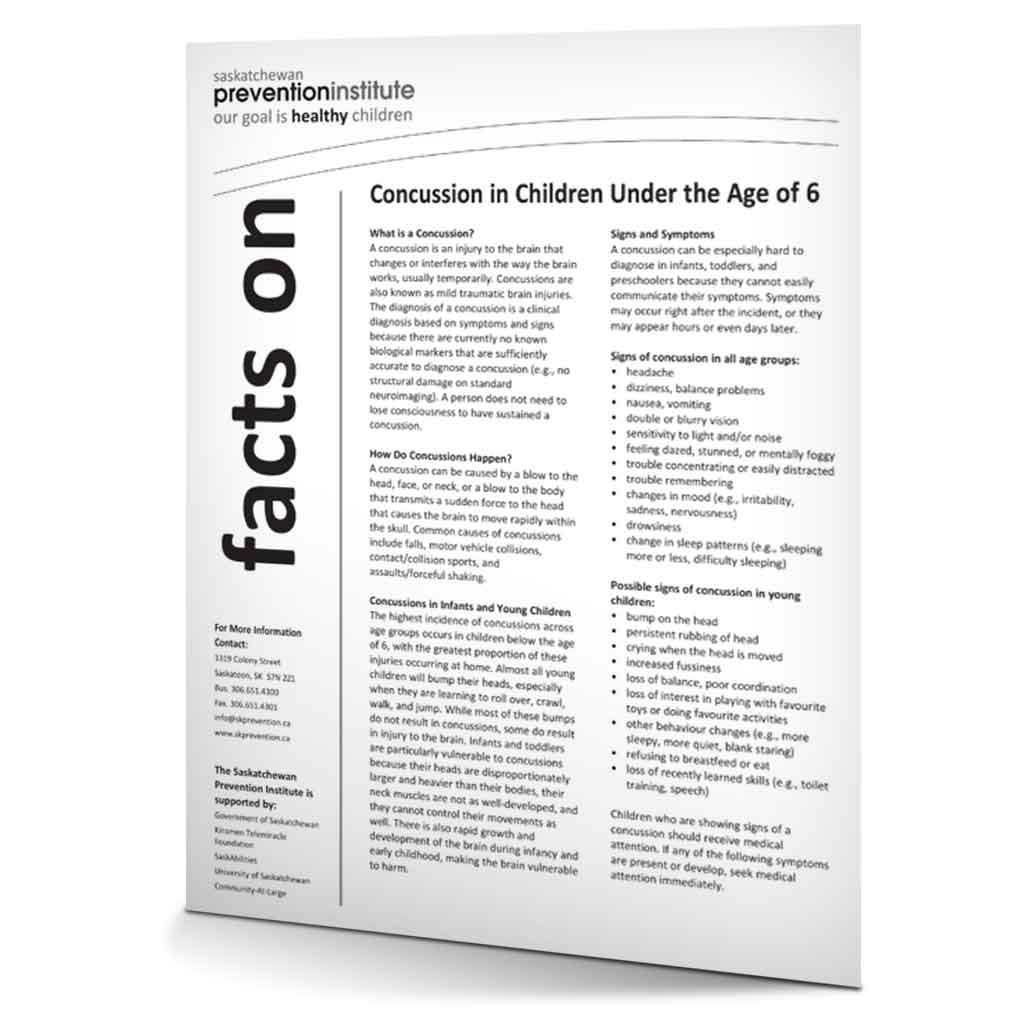
Concussion in Children Under the Age of 6
Fact Sheet, 2019
Although the majority of concussions are minor, they can have serious outcomes for children under the age of six. This fact sheet defines what a concussion is, how concussions happen, and the signs and symptoms of a concussion. Information on treatment, potential long-term outcomes, and prevention is also provided. Aimed at health professionals and service providers who work with families.
SKU: 4-001 -
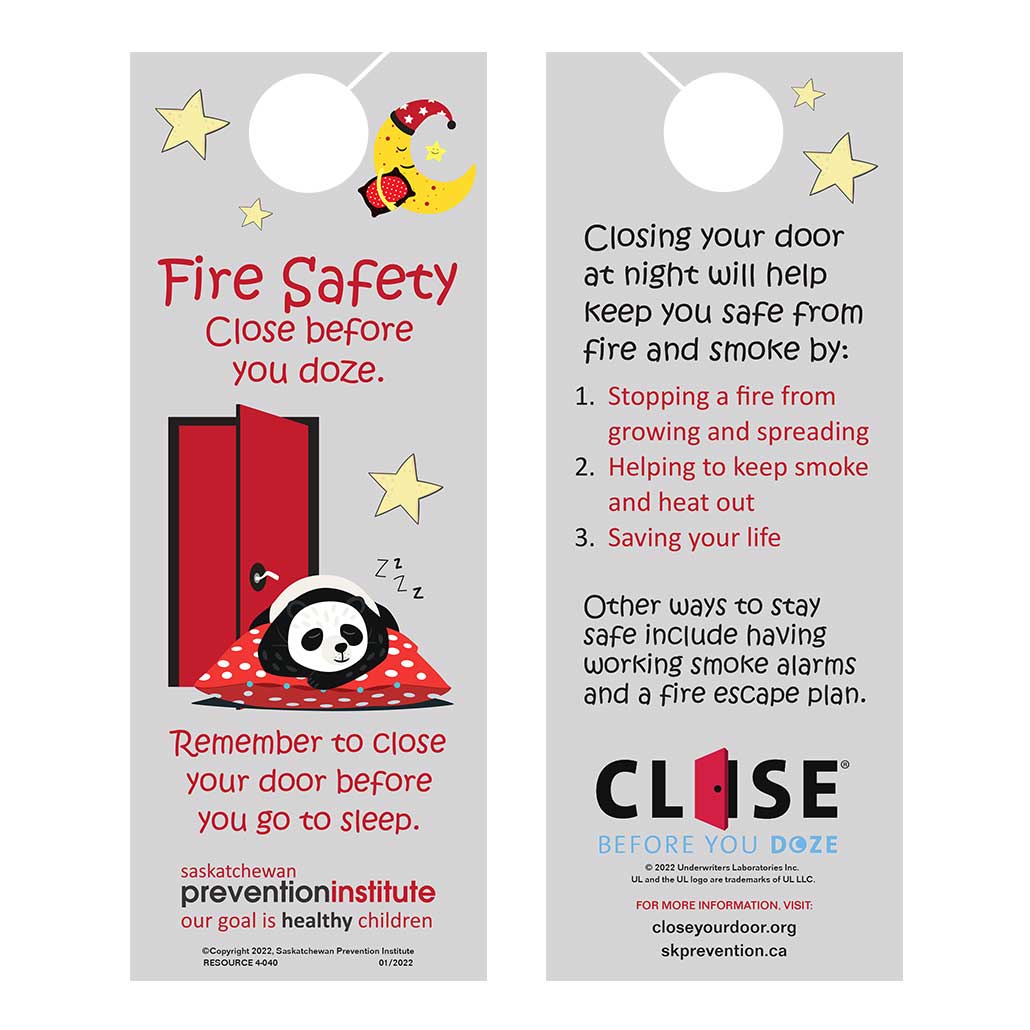
Close Before You Doze Door Hanger
Informational Door Hanger, 2022
This resource outlines the importance of closing bedroom doors before going to sleep to reduce the risks associated with fire and smoke. It is intended to be used as a door hanger for children’s bedrooms.
SKU: 4-040
